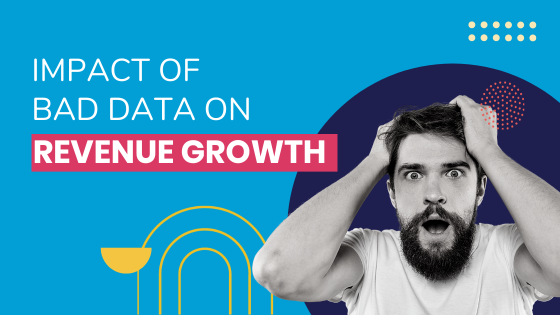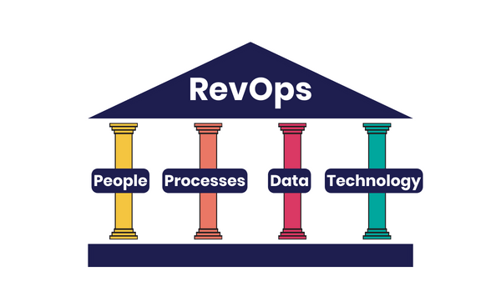






Data integrity plays pivotal role in your RevOps framework. Being one of the most important pillars that RevOps stands tall on, data is the glue that keeps everything together, enabling informed decisions, trend identification, performance tracking, and process optimisation.
But without a well-organised data management infrastructure, your data won't be accurate or reliable; hence, your RevOps framework may fall apart.
In this blog, we'll discuss the common data issues in RevOps, impact of bad data on revenue growth, tips for avoiding data errors and improving revenue with clean data.
Role of Data Quality in RevOps

You can't really build a successful revenue operations (RevOps) strategy without quality data now, can you?
A good RevOps framework stands tall on four pillars: people, processes, technology, and data - and if any of these pillars are faulty your RevOps strategy is bound to fall apart. Maybe not at the moment or in the near future, but it's inevitable! These pillars form the foundation of a successful RevOps strategy, and data is undeniably one of the most critical elements.
RevOps is all about alignment and collaboration within teams to maximise revenue growth, and this seamless integration of teams relies heavily on accurate, timely, and comprehensive data.
Accurate data is the glue that holds the RevOps strategy together by enabling informed decision-making, identification of trends, performance tracking, and process optimisation. Moreover, it enables all the teams to look at the customer journey holistically to identify all the possible touchpoints to enhance customer experience and facilitate data-driven revenue growth.
What Causes Bad Quality Data?
Before we dive into the impact of bad data on revenue growth, let's first understand the source of bad quality data:
1. Manual data entry
When teams opt for manual data entry instead of relying on automation to do the heavy lifting, it's not uncommon to encounter inconsistencies and errors due to human error. We're only humans after all, right?
Nevertheless, these errors such as typos, misspellings, and incorrect information entered by individuals can result in inconsistencies in customer profiles, sales leads, and other vital datasets.
2. Lack of data governance
Absence of data governance framework including standardised data entry protocols, validation rules, and quality monitoring, can contribute to inconsistencies and poor data quality within the RevOps framework along with compliance issues raising security concerns.
3. Duplicate entries
With system integrations, data imports, or data merging activities in the picture many duplicate entries arise. If not identified and addressed promptly, duplicate records can lead to confusion and misalignment across RevOps functions.
4. Data silos caused by tech stack
When different teams work with different tools, or if a company's tech stack is not integrated properly it hampers with the seamless flow of data resulting in data silos and inconsistencies.
How Bad Data Affects Your RevOps Strategy?
With all the inconsistencies, errors and silos looming over your data, your RevOps strategy can't possibly succeed. While there is a negative impact of bad data on revenue growth, it also affects your operational efficiency, team alignment, and most importantly customer experience.
1. Damaged customer experience
Data inaccuracies can lead to unsatisfactory customer experience. For instance, incorrect contact information can prevent successful communication, while flawed purchase histories may affect the personalisation of services and offers, potentially damaging trust and loyalty.
2. Resource Wastage
Time and money spent on correcting errors due to bad data constitute significant resource wastage. RevOps teams can find themselves focusing on damage control rather than proactive strategy execution and innovation.
3. Data security risks
Keeping inaccurate or outdated data can result in breaches of data protection regulations such as GDPR (General Data Protection Regulation). Non-compliance not only attracts legal penalties but can also harm the company's reputation and customer trust.
4. Revenue leakage
Bad data contributes to revenue leakage through missed sales opportunities and billing errors. Incomplete or inaccurate data can result in underpricing, disputes, and overlooked revenue streams, impacting the overall financial health of the organisation.
5. Misalignment within teams
Inconsistencies in lead data, customer preferences, and communication records create obstacles for collaborative endeavours, leading teams to work with contradictory or obsolete information. This disruption in alignment not only obstructs the smooth exchange of information but also undermines the trust between teams.
RevOps Optimisation Strategies
Data accuracy in sales and marketing can help significantly in improving revenue with clean data. Guess it's a good thing that RevOps is big on optimising and improving processes.
Let's discuss some ways to tackle common data issues in RevOps and improve data quality:
1. Centralise data from all sources
Start by identifying all the sources of data within various processes, departments, and systems. This will allow you to centralise data from every nook and corner of your organisation. Now what?
Having centralised all this data will pave way for you to identify what reports are needed, which duplicate or faintly similar reports can be clubbed together, which ones need to be audited, and the list goes on.
While this may not seem like a big deal, this step is crucial to resolve common data issues in RevOps as it opens the floor for discussion and set your organisation up for data-driven revenue growth.
2. Establish Data Standards
Next up - automation.
Let your tech stack do the heavy-lifting for you by automating data entry to eliminate human errors, and by setting up specific data formats, accuracy requirements, and periodic data audits you can continue to maintain data integrity.
3. Regular Training and Education
It's crucial for organisations to keep their teams in the loop through regular training sessions on the nitty-gritty of data quality and governance. When everyone is on the same page and knows exactly how to maintain data quality - half of your common data issues in RevOps will get solved.
4. Data Ownership and Accountability
Let's make sure we've got someone keeping an eye on our data's well-being, shall we? By assigning ownership to take care of the quality and governance of data in their respective areas, your team members can ensure whether all the rules and policies for data management are being followed or not.
5. Data Cleansing
By removing duplicates, filling in missing data, and correcting errors, data cleansing can help enhance the data integrity within your RevOps framework leading to more precise insights, better decision making, and ultimately, superior business outcomes.
In fact, you don't even have to put in a lot of manual effort for data cleansing, as HubSpot lets you easily automate this process - using HubSpot Operations Hub lets you take control of your data, ensuring it's clean, clear, and well-organised.
How Your Tech Stack Can Help?
A well-designed and seamlessly integrated tech stack can prove very useful to enhance data quality and data management within RevOps. By streamlining the flow of data across various tools and teams, you can ensure a cohesive ecosystem where information is consistent and up-to-date facilitating data accuracy in sales and marketing.
The integration of automation features within the tech stack helps eliminate errors that may occur during manual data entry, while data validation mechanisms work to improve accuracy.
The result is a synchronised, reliable data infrastructure that empowers RevOps teams with accurate insights, ultimately optimising decision-making processes, improving customer interactions, and contributing to the overall success of data-driven revenue growth.








